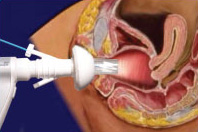
Photo from wikipedia
OBJECTIVE This Committee Opinion outlines the gynaecologic management recommendations for women diagnosed with hereditary breast and ovarian cancer syndrome (HBOC) with respect to screening, contraception, chemoprophylaxis, fertility considerations, risk-reducing surgery,… Click to show full abstract
OBJECTIVE This Committee Opinion outlines the gynaecologic management recommendations for women diagnosed with hereditary breast and ovarian cancer syndrome (HBOC) with respect to screening, contraception, chemoprophylaxis, fertility considerations, risk-reducing surgery, and post-oophorectomy care. INTENDED USERS This Committee Opinion is designed for gynaecologic oncologists, general gynaecologists, family physicians, genetic counsellors, registered nurses, nurse practitioners, residents, and health care providers. TARGET POPULATION Adult women (18 years and older) with a pathogenic germline variant in the BRCA1, BRCA2, and other ovarian cancer-associated genes. EVIDENCE While reviewing evidence, databases searched include Medline, Cochrane, and PubMed. Medical Subject Heading search terms used include BRCA AND gynaecology management, hormone replacement therapy, risk reduction, chemoprophylaxis, fertility from 01/2010 and 10/2017. Literature search was begun 07/2017 and finalized 10/2017. In total 183 studies were identified, and 101 were used. VALIDATION METHODS The content and recommendations were drafted and agreed upon by the principal authors. The Board of the Society of Obstetricians and Gynaecologists of Canada approved the final draft for publication. The quality of evidence was rated using the criteria described in the Grading of Recommendations Assessment, Development, and Evaluation (GRADE) methodology framework (Table 1). The interpretation of strong and conditional (weak) recommendations is described in Table 2. The Summary of Findings is available upon request. BENEFITS, HARMS, AND COSTS We may expect a risk reduction of up to 90% in women predisposed to HBOC who undergo risk-reducing bilateral salpingo-oophorectomy. The harms of iatrogenic premature menopause are offset by the benefits of risk reduction. By minimizing potential tubal/ovarian/peritoneal cancers, we can expect savings to the health care system. GUIDELINE UPDATE Evidence will be reviewed 5 years after publication to decide whether all or part of the opinion should be updated. However, if important new evidence is published prior to the 5-year cycle, the review process may be accelerated for a more rapid update of some recommendations. SPONSORS This guideline was developed with resources funded by the Society of Obstetricians and Gynaecologists of Canada. RECOMMENDATIONS
Journal Title: Journal of obstetrics and gynaecology Canada : JOGC = Journal d'obstetrique et gynecologie du Canada : JOGC
Year Published: 2018
Link to full text (if available)
Share on Social Media: Sign Up to like & get
recommendations!